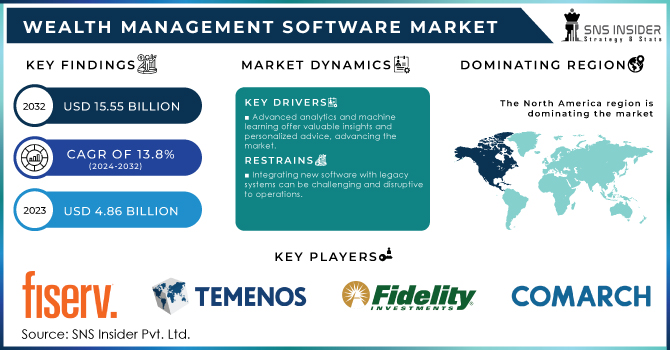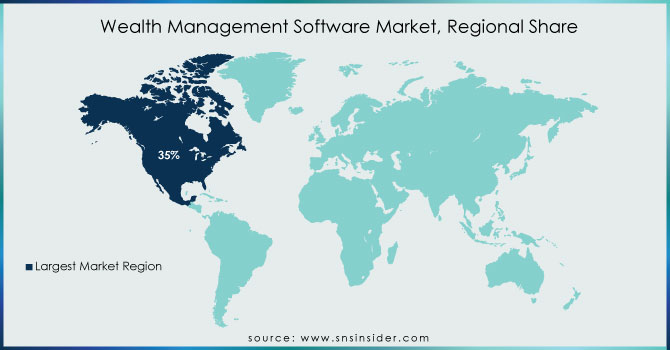Wealth Management Software Market Size Analysis:
The Wealth Management Software Market was worth USD 4.86 billion in 2023 and is predicted to be worth USD 15.55 billion by 2032, growing at a CAGR of 13.8% between 2024 and 2032.

Get more information on Wealth Management Software Market Market - Request Free Sample Report
Increasing acceptance of advanced technologies in wealth management advisory is a key factor driver the growth of market. Better growth is anticipated in this market, because of the innovations on financial technology that are having a shift towards automation & specific enhancements into the offerings available now under financial services. This trend is expected to increase as the need for automation in wealth management rises, and more platforms with automated workflows are introduced along with comprehensive wealth management solution. Features like open architecture, omnibus access and digital integration are at the core of these platforms which make managing wealth more efficient.
Wealth managers are also reacting to increasing demands from affluent clients growing demand for diverse investments, financial security, and personalized services. Wealth managers have always offered a high level of services, which is not surprising since their clients are people with significant means who in theory could afford only the best of service. Wealth management software, ideally on the open financial platform, can facilitate this trend by providing extended strategic and analytical capabilities serving to meet a new demand of HNWIs for greater control & transparency in wealth management. U.S. FAs (financial advisors) will spend an estimated $1.2 bn on wealth management software solutions in 2024, reflecting a significant increase in technology adoption. Nearly 67% of U.S. wealth management firms have adopted cloud-based solutions, up from 55% in 2022. The China’s burgeoning base of online wealth management users and an expanding Fintech industry that reflect broader global trends. By early 2024, nearly 70% of financial advisors in North America will employ wealth management software to scale service delivery and optimize operations. As the technology continues to mature, adoption is only expected to increase. The average revenue growth rates of wealth management software vendors is now almost 12% per year.
Market Dynamics
Drivers
-
The adoption of advanced financial technology is enhancing efficiency and service quality in wealth management, driving market growth.
-
Rising demand for automation in wealth management improves operational efficiency and data management, fuelling software adoption.
-
Advanced analytics and machine learning offer valuable insights and personalized advice, advancing the market.
The increase in the adoption of financial technology (fintech) is playing a major role for the growth of wealth management software market. Tech solutions in the financial services industry are being adopted more widespread to improve internal operations and provide a better service all-around for clients. A report by Deloitte states that 80% of wealth management firms are putting resources in technology to remain competitive and deliver services according to their clients' changing circumstances. That is what the growing focus on digital tools that automate low-interest but complex processes and decisions suggests. For instance, the growth of robo-advisors employing algorithms that offer financial advice with minimal human intervention is one. By early 2024, the total global assets under robo-advisory groing with significant growth rate exemplifying their growing significance in wealth management. They create the cost-effective and enabled broad client base for driving fintech adoption in this sector.
The evolution of data analytics and machine learning are boosting features available in wealth management software. Firms, for example are widely adopting predictive analytics to offer personalized investment solutions. A suit by Capgemini discloses that 70% of wealth managers use advanced analytics to better an understanding of client behaviour and preferences resulting in more knowledgeable, personalized financial advice.
Restraints
-
Substantial initial and maintenance costs can deter smaller firms from adopting advanced wealth management software.
-
Integrating new software with legacy systems can be challenging and disruptive to operations.
-
The need for robust data security measures can be costly and may raise concerns about privacy.
The data security and privacy concerns are one of a major factor that are restraining the global Wealth Management Software market. As the amounts of financial data handled by these systems has increased, it is critical to provide strong security controls. This underscores the significant monetary impacts of security breaches. stringent data protection regulations in several countries, like the General Data Protection Regulation (GDPR) for European nations and the California Consumer Privacy Act (CCPA) within the US are also increasing pressure on wealth management firms to enhance their data security. These regulations impose strict requirements on how personal data must be handled, leading to increased costs for compliance and risk management. Applying these standards to wealth management software often entails complexity and a significant financial investment.
Segment Analysis
By Application
The segment of portfolio, accounting and trading management dominated the market in 2023, contributed a revenue share more than 22%. The rise in demand for portfolio management and trading solutions accounts for the major share of this segment. This platform provides trading managers with a chance to concentrate of teamwork and increase customer service. As increase in pressure develops to handle customer info, stockholders, portfolio managers as well as trading manager are very quickly moving adopting wealth management solutions.
Wealth managers are using these platforms to streamline financial data and help clients make decisions. Moreover, financial advice and management segment is estimated to expand at the highest CAGR over the forecast period. Digitization has been a common trend in enterprises across the globe owing to which businesses are focusing on digitizing business processes, improving operational efficiency and increasing customer relationship management thus shifting their focus towards financial advice & solutions., is expected to drive demand for Financial Advice Solution & services market. Wealth management firms are increasingly using these software solutions to manage their client base more effectively. Integrated financial tools also help boost collaboration with clients making it easier to team up and provide information in a single space, create investment proposals, identify financial goals, and deliver better financial advice.
By End-use
In 2023, the banks sector held the largest share of revenue in this market which accounted for more than 27% revenue share. When the world economy continues to grow at a slow pace, people's money and wealth are increasing assets and wealth of individuals. They are also adopting wealth management software to enhance their client-focused services. There are many other companies offering wealth management and processing solutions to address the changing landscape of banks, reduce cost-to-serve and effect low touch operations in global markets.
Trading & exchange firms is expected to be the fastest growing segment in this segment, over the forecast period. Technological advancements are opening up completely new dimensions in this area for wealth management software. With that in mind, trading and exchange firms have also begun to utilize these solutions more frequently for managing client assets. Moreover, the digitalization in trading firms is enabling clients to easily access their accounts and monitor their financial portfolios, which is driving further growth in this sector.
Regional analysis
North America, in 2023 held a dominant position, accounting for over 35% of the revenue share. The region has seen an increase in High-Net-Worth Individuals (HNWIs), who have a growing appetite for more advanced financial advisory services. They are also home to a sizeable pool of well-established market players and rapidly digitalizing financial industry spread across multiple countries. Retail high value customers rely on wealth management services for retention and acquisition. Affluent mass customers in the region contribute significantly to the net income of retail banks. In May 2023, where American Bank & Trust has teamed up with wealth tech provider Marstone to launch a new digital wealth management platform. Operated by the banks trust arm, which has over USD 300 million in assets under management (AUM), it is designed to increase bank efficiency whilst keeping client deposits and draws on retail relationships. More than 60 percent of U.S. wealth management firms are embedding automated advisors in their software to improve client engagement and efficiency.
In the regional markets, Asia Pacific is anticipated to grow with a faster annual growth rate during forecast period. The region has been identified as a lucrative environment for robo-advisors given higher rates of digital platform usage. Tech-savvy customers are increasingly adopting robo-advisory solutions that leverage sophisticated marginal analytics and high-end algorithms for optimizing their investment decisions more effectively. Moreover, rapid increase in small & medium enterprises (SMEs) across developing economies such as China and India is anticipated to offer numerous growth prospects for this market. If so, it could lead to increased demand for digital financial services that will aid their business capabilities throughout the deployment of modern IT infrastructure.

Get More Information on Wealth Management Software Market - Enquiry Now
KEY PLAYERS
The major key players in wealth management software market are Fiserv, Inc., Temenos Headquarters SA, Fidelity National Information Services, Inc., Profile Software, SS&C Technologies Holdings, Inc., SEI Investments Company, Finantix, Comarch SA, Objectway S.P.A., and Dorsum Ltd.and other players.
Recent Developments
-
Earned Wealth revealed it secured $200 million in funding for its practice management solutions that offer financial advice aimed at supporting their professional and personal needs in July 2024.
-
Wells Fargo introduced a digital service for wealth-management clients in February 2023 to help them budget and manage their financials. Wells Fargo app users should have been able to access the more than 2.6 million clients in its wealth and investment management division on a broad, new LifeSync platform by the end of March
-
WealthTech GBST was rebranded and started selling an updated version of its SaaS Composer wealth-based administration software in March 2023. The company however was still its name and launched a new brand strategy with visual identity to reflect the revised backronym.
| Report Attributes | Details |
| Market Size in 2023 | US$ 4.86 Bn |
| Market Size by 2032 | US$ 15.55 Bn |
| CAGR | CAGR of 13.8% From 2024 to 2032 |
| Base Year | 2023 |
| Forecast Period | 2024-2032 |
| Historical Data | 2020-2022 |
| Report Scope & Coverage | Market Size, Segments Analysis, Competitive Landscape, Regional Analysis, DROC & SWOT Analysis, Forecast Outlook |
| Key Segments | • By Advisory Mode (Human Advisory, Robo Advisory, Hybrid) • By Deployment (Cloud, On-premise) • By Enterprise Size (Large Enterprises, Small & Medium Enterprises) • By Application (Financial Advice & Management, Portfolio, Accounting, & Trading Management, Performance Management, Risk & Compliance Management, Reporting, Others) • By End-use (Banks, Investment Management Firms, Trading & Exchange Firms, Brokerage Firms, Others) |
| Regional Analysis/Coverage | North America (US, Canada, Mexico), Europe (Eastern Europe [Poland, Romania, Hungary, Turkey, Rest of Eastern Europe] Western Europe] Germany, France, UK, Italy, Spain, Netherlands, Switzerland, Austria, Rest of Western Europe]). Asia Pacific (China, India, Japan, South Korea, Vietnam, Singapore, Australia, Rest of Asia Pacific), Middle East & Africa (Middle East [UAE, Egypt, Saudi Arabia, Qatar, Rest of Middle East], Africa [Nigeria, South Africa, Rest of Africa], Latin America (Brazil, Argentina, Colombia Rest of Latin America) |
| Company Profiles | Fiserv, Inc., Temenos Headquarters SA, Fidelity National Information Services, Inc., Profile Software, SS&C Technologies Holdings, Inc., SEI Investments Company, Finantix, Comarch SA, Objectway S.p.A., and Dorsum Ltd. |
| Key Drivers | • The adoption of advanced financial technology is enhancing efficiency and service quality in wealth management, driving market growth. • Rising demand for automation in wealth management improves operational efficiency and data management, fuelling software adoption. |
| Market Restraints | • Substantial initial and maintenance costs can deter smaller firms from adopting advanced wealth management software. • Integrating new software with legacy systems can be challenging and disruptive to operations. |

